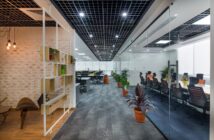By: Filippo Sarti
 Gone are the days when we were chained to our desk from 9 to 5. How we work is changing. The idea of a “Third Place,” a space that’s neither home nor office but where people want to spend a portion of their lives, was introduced as far back as 1989 in Ray Oldenburg’s book “The Great Good Place.” Today, thanks to the advent of wireless technology, the concept has evolved from being merely from a civic or entertainment space and now also applies to a flexible work space for mobile employees.
Gone are the days when we were chained to our desk from 9 to 5. How we work is changing. The idea of a “Third Place,” a space that’s neither home nor office but where people want to spend a portion of their lives, was introduced as far back as 1989 in Ray Oldenburg’s book “The Great Good Place.” Today, thanks to the advent of wireless technology, the concept has evolved from being merely from a civic or entertainment space and now also applies to a flexible work space for mobile employees.
So what does this mean for businesses? According to Kyran Sze, executive director of the architecture firm Aedas, the push towards Third Places is gathering pace in Asia. He has another idea in mind for the new sort of hubs designed to meet the needs of an increasingly mobile work force. “It’s not too different from love hotels, or a car park,” Sze jokes. “It’s a free space that you can corner for a certain period of time, where business activities can be carried out, and you share common facilities with others as well. It’s a fluid space where people can come in and out.”
A report issued this year by the technology market research company IDC suggests that Asia will see the biggest increase in mobile workers over the next two years. By 2013, 1.2 billion people, one-third of the world’s total work force, will be mobile workers, the company finds, and 62% of them will be based in Asia.
The push to more adaptable working environments will likely come from both the needs of companies and the people they employ. Studies show that at any one time, only between 40% and 60% of all office space is being used.
So the benefits in terms of efficiency are substantial. According to the latest Regus Business Tracker survey, 45% of companies around the world expect to add staff to their payroll next year, compared with 9% looking to cut headcount. But a net 41% of companies are still looking to reduce their overheads – not through staff cuts but more efficient corporate infrastructures and management.
The social and professional benefits are also clear for workers. Third Places are more flexible than offices. They are closer to home, meaning less commute time and a lower environmental burden. People find themselves more able to set their work schedule to suit them, with Third Places also tailor made for the needs of a work force that’s increasingly free-lance and free-form.
Japan and the United States – not coincidentally two of the three largest economies, alongside China — are at the forefront of the trend. The U.S. work force is currently the most flexible in its use of work space, with 72.2% of employees already able to work out of the office, rising to 75.5% in 2013.
Japan’s penetration rate of mobile workers is due to hit 74.5% in two years. Given that some jobs have to be performed in a set work place – you can’t manufacture an automobile, or salvage one for that matter, on the fly – that will mean both countries have hit their maximum rate of mobility for the work force, according to IDC.
Kenichi Nakaya has witnessed the boom in mobile workers in his native Japan and outlined what it means in his book “Nomad Working,” which came out in June 2010. He says it’s normally immediately obvious what kind of benefits nomads receive in their work life, but it can be a tougher sell for the companies that hire them. “From the viewpoint of the worker, mobile working is very in fashion, and they like it because they can use their time freely, and more efficiently,” Nakaya notes.”
Managing employees at first often seems like the most serious challenge that would prevent more a flexible approach to work. But it is ultimately less of a concern, workplace consultants say, provided appropriate measures are put in place to reward productivity and efficiency rather than merely “face time” in the office.
“If you get it right it is tremendously empowering,” Paul Scroggie the director of workplace management services at the Hong Kong office of Knight Frank, says. “Basically what you are saying is I trust you, go and work where you need to, when you need to.”
When implementing a flexible workplace it is essential that a company first identify exactly what it aims to achieve. Once this is done, communicating this properly and getting everyone to buy in is vital step, work-space consultants say.
“Everybody thinks it’s about space and it’s about cost. But it’s nothing about space and it’s nothing about cost and it’s all about people,” Scroggie says. “If you get the people component right then you do save space and you do save cost. Often companies sell it as a cost saving measure. And people don’t like that.”
To embrace flexible working successfully, companies also have to shift their focus towards measuring productivity – instead of simply profitability. Those that do so and adequately prepare for a flexible work force in Asia now will be at the forefront of the mobile work movement, and able to capitalise on the region’s shift from a manufacturing base to an increased focus on service industries.
Susan Lim, the managing director of DEGW Asia, which specialises in consulting with companies on their use of space, sees two main trends emerging in Asia. The first is that the office is becoming a city, with distinct places for collaboration, meeting, quiet concentration; the second is that the city is becoming an office, with wireless Internet connections making anywhere a possible work place.
“The thing these days is that the notion of work can be separated from the notion of the office,” Lim says. “Work used to be a place that you went to. Now work is a thing you do, not necessarily a place.”
In cities such as Hong Kong, Tokyo, and Mumbai, which boast some of the world’s highest rents, there are substantial cost savings from shedding permanent office leases. Other Asian capitals, clogged with traffic, call for more flexible working arrangements to save time.
In Beijing for example, Nokia have chosen to forgo costly and ineffective sales and marketing offices, and instead use Regus’ network of eight business centers across the city as their Third Place. Their on-the-road workforce can touch down at a Regus Business Lounge, take a day-office or use a meeting space if necessary, saving the company a significant investment in real estate.
However, business case aside the fundamental driver behind the Third Place is that, freed by technology to do their jobs where they want, people demand them.
Nakaya says he frequently feels sleepy in a traditional office environment, which he finds oppressive and unnatural. He feels more alive when he’s working in a Third Place, whether it’s a coffee shop or business hub.
“The traditional office is a very artificial place. We can and we should a third place that is better to us,” he says.
The author, Filippo Sarti, is Global COO and CEO Asia-Pacific for workplace solutions provider, Regus.





